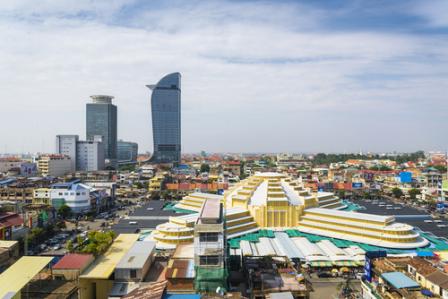By: East Asia Forum Date: 13 November 2014
After the global recession in 2009, Cambodia’s economy recovered steadily with its GDP growing at an average rate of 7 percent per year in 2010–13. It is expected to maintain its growth rate of 7 percent this year.

Phnom Penh
But despite these rosy short-term prospects, Cambodia’s long-term growth prospects might be hampered by its low competitiveness. It has persistently underperformed in the World Economic Forum’s Global Competitiveness Index. In 2014, Cambodia ranked 95 out of 144 countries, down from 88 in 2013. Weak institutions, poor infrastructure, low-quality higher education and training, and lack of innovation inhibit Cambodia’s overall competitiveness. Apart from Myanmar, Cambodia was the lowest ranked country in the region. Singapore, Malaysia, Thailand and Indonesia were all in the top five.
Corruption and weak institutions hold Cambodia back from becoming truly competitive. Cambodia remains one of the most corrupt countries in the world. Despite adopting the Anti-Corruption Law in 2010, corruption is still widespread in Cambodia. Corruption weakens the judiciary, the police force and other state institutions. Favouritism by government officials and impunity is commonplace. The lack of a clear distinction between the courts and the executive branch of government has also led to deep politicisation of the judicial system.
The lack of infrastructure is one of the biggest challenges for Cambodia’s growth and overall competitiveness. Cambodia’s infrastructure is less developed than its neighbouring countries. Only half of its 2-digit national roads and only 15 percent of provincial roads are paved. The railway system is underdeveloped and under-utilised. Only 6 percent of the population uses the internet, and access to electricity is still limited and expensive.
Cambodia also underperforms in delivering high-quality higher education and training. While the enrolment rate has increased, the sector is still plagued with numerous challenges. Most universities lack learning and teaching resources and facilities, and qualified academic staff are in short supply. Higher education programs are largely driven by commercial interests, focusing on a fewbusiness-related courses while mathematics and science subjects are lacking. Soft skill training is missing and research activity is limited.
Perhaps the biggest challenge Cambodia faces is the lack of innovation. Cambodia’s ability to innovate is just a little above that of Myanmar’s but below the rest of its neighbours’. The main barriers are the lack of quality scientific research institutions, the limited number of scientists and engineers, the lack of resources dedicated to research and development, and insufficient collaboration between industriesand universities for research and development activities.
The lack of competitiveness could be a larger problem when Cambodia faces off against its neighbours following the ASEAN economic integration. Unless Cambodia enacts comprehensive, effective and timely polices to improve its competitiveness, it will lose the competition, affecting its long-term development. There are three keys to unlocking Cambodia’s growth.
First, Cambodia should take action to ensure that state institutions function effectively. The government’s anti-corruption strategies and agencies need to be strengthened to minimise rent-seeking and nepotism. The judicial system should be made fully independent to conduct objective evaluation and application of the law.
Second, Cambodia needs to invest in key infrastructure such as roads, railways, energy supplies and internet access. It needs to rehabilitate high-priority road networks and bridges to facilitate the growth of agriculture, tourism and trade in rural areas. Cambodia’s existing infrastructure around its ports and airports should be efficient enough to handle forthcoming increases in production and trade.
Third, Cambodia needs to improve the quality of its higher education. Higher education plays a vital role in building up a competitive workforce for Cambodia. Improving the quality of higher education would ensure that Cambodia meets its current and future human capital needs, and allow Cambodia to benefit from the ASEAN integration in 2015. Cambodia needs financial resources to improve education infrastructure, update the curriculum and teaching methods, and recruit well-qualified teaching staff. Research should also be promoted, and internal quality assurance should be the top agenda for all higher education institutions.
Strengthening institutions, modernising infrastructure and enhancing the quality of education would contribute to improving innovation and Cambodia’s overall competitiveness. More needs to be done to create an enabling environment to support innovators. For example, Cambodia should enact policies to stimulate technological development and promote collaboration in research and development activities. Cambodia must make an effort to remove bureaucratic and regulatory obstacles toentrepreneurial activities, which can stifle innovation.
Cambodia has come a long way in terms of growth and poverty reduction. Now it is time for the country to focus on improving its competitiveness to sustain long-term economic and social development. If Cambodia gets this right, it would be on track to integrate itself into the region and the world.
Three keys to unlocking Cambodia’s growth is republished with permission from East Asia Forum

No comments:
Post a Comment